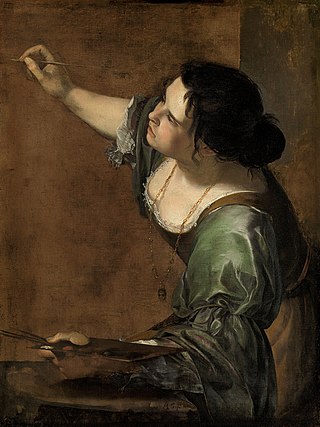
Artemisia Lomi or Artemisia Gentileschi was an Italian Baroque painter. Gentileschi is considered among the most accomplished seventeenth-century artists, initially working in the style of Caravaggio. She was producing professional work by the age of 15. In an era when women had few opportunities to pursue artistic training or work as professional artists, Gentileschi was the first woman to become a member of the Accademia di Arte del Disegno in Florence and she had an international clientele.

Orazio Lomi Gentileschi (1563–1639) was an Italian painter. Born in Tuscany, he began his career in Rome, painting in a Mannerist style, much of his work consisting of painting the figures within the decorative schemes of other artists.

The Bilbao Fine Arts Museum is an art museum located in the city of Bilbao, Spain. The building of the museum is located entirely inside the city's Doña Casilda Iturrizar park.
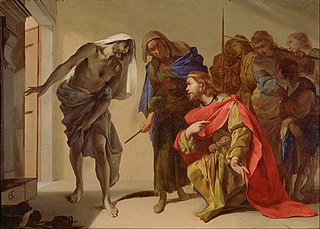
Bernardo Cavallino (1616–1656) was an Italian painter and draughtsman. He is regarded as one of the most original painters active in Naples during the first half of the 17th century.

Judith Slaying Holofernes is a painting by the Italian early Baroque artist Artemisia Gentileschi, completed in 1612-13 and now at the Museo Capodimonte, Naples, Italy. The picture is considered one of her iconic works. The canvas shows Judith beheading Holofernes. The subject takes an episode from the apocryphal Book of Judith in the Old Testament, which recounts the assassination of the Assyrian general Holofernes by the Israelite heroine Judith. The painting shows the moment when Judith, helped by her maidservant Abra, beheads the general after he has fallen asleep in a drunken stupor. She painted a second version now in the Uffizi, Florence, somewhere between 1613 and 1621.

Agnus Dei is an oil painting completed between 1635 and 1640 by the Spanish Baroque artist Francisco de Zurbarán. It is housed in the Prado Museum in Madrid, Spain.
Lot and his Daughters, or Lot and his Daughters, with Sodom and Gomorrah Burning is a subject in art showing Lot from the Hebrew Bible and his two daughters.

Danaë is a circa 1623 oil on canvas painting by the Italian artist Orazio Gentileschi. It is an example of an Italian Baroque painting and is now in the collection of the J. Paul Getty Museum, in Los Angeles.

Judith and her Maidservant is a c. 1615 painting by the Italian baroque artist Artemisia Gentileschi. The painting depicts Judith and her maidservant leaving the scene where they have just beheaded general Holofernes, whose head is in the basket carried by the maidservant. It hangs in the Pitti Palace, Florence.
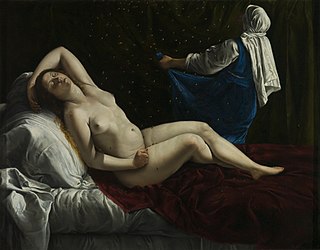
Danaë is a 1612 painting by the Italian Baroque artist Artemisia Gentileschi. It hangs in the Saint Louis Art Museum, United States.

Judith and Her Maidservant is one of four paintings by the Italian baroque artist Artemisia Gentileschi that depicts the biblical story of Judith and Holofernes. This particular work, executed in about 1623 to 1625, now hangs in the Detroit Institute of Arts. The narrative is taken from the deuterocanonical Book of Judith, in which Judith seduces and then murders the general Holofernes. This precise moment illustrates the maidservant Abra wrapping the severed head in a bag, moments after the murder, while Judith keeps watch. The other three paintings are now shown in the Museo di Capodimonte in Naples, the Palazzo Pitti in Florence, and the Musée de la Castre in Cannes.
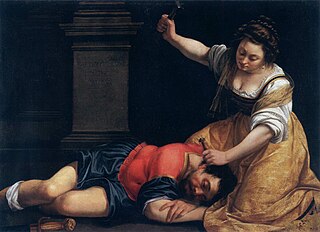
Jael and Sisera is a painting by the Italian Baroque artist Artemisia Gentileschi, executed around 1620.
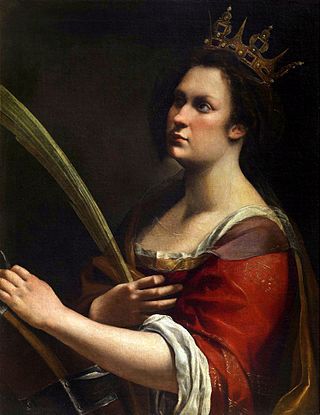
Saint Catherine of Alexandra is a painting by the Italian Baroque artist Artemisia Gentileschi. It is in the collection of the Uffizi, Florence. Gentileschi likely used the same cartoon or preparatory drawing to create both this painting and the Self-Portrait as Saint Catherine of Alexandria (1615–1617), now in the National Gallery, London.
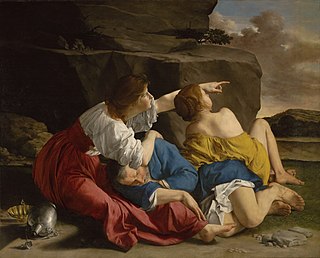
Lot and His Daughters is a 1622 painting by Orazio Gentileschi. Executed in oil on canvas, the large painting depicts the Biblical tale of Lot and his two daughters after the destruction of Sodom.

The Birth of Saint John the Baptist, by Artemisia Gentileschi, was part of a six-painting portrayal of Saint John's life, with four of the paintings by Massimo Stanzione and one by Paolo Finoglia, for the Hermitage of San Juan Bautista on the grounds of Buen Rierto in Madrid, under orders from the Viceroy of Naples, the Conde de Monterrey. Although a date has not been agreed upon by scholars, Artemesia most likely painted The Birth of Saint John the Baptist between 1633 and 1635. It is one of the most renowned works from Artemisia's Naples period, especially due to its detailed rendering of fabrics and floor tiles.

Saint Januarius in the Amphitheatre at Pozzuoli is a 1635-1637 oil on canvas painting by Artemisia Gentileschi. The work shows the moment that the Christian martyr Januarius and his followers are thrown to a group of wild animals in the amphitheatre in Pozzuoli - however, they lick the saint's feet rather than attacking him and Januarius is unharmed.

Cleopatra is a 1611-1612 oil on canvas painting of Cleopatra by Artemisia Gentileschi, now in the private Etro collection in Milan.
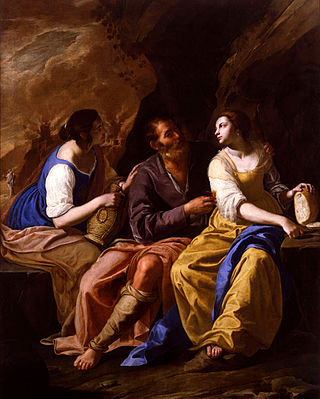
Lot and His Daughters is a 1636-1638 painting by Artemisia Gentileschi, now in the Toledo Museum of Art.

The Finding of Moses is an early 1630s painting by Orazio Gentileschi. There are two versions, the prime version is in The National Gallery in London and the second is in Museo del Prado in Madrid.

Bathsheba is a 1636-37 painting by the Baroque painter Artemisia Gentileschi, with contributions by Viviano Codazzi and Domenico Gargiulo. It shows the Hittite woman Bathsheba being washed and tended to by her servants. At the top left of the painting, King David sees her from his palace. It was one of seven versions from the story of Bathsheba that Gentileschi painted.



















